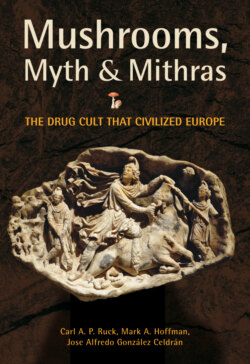Читать книгу Mushrooms, Myth and Mithras - Carl Ruck - Страница 20
На сайте Литреса книга снята с продажи.
Fruit of the Pine Tree
ОглавлениеThe rock sometimes identified as a pinecone.70 A statue from the Carnutum Mithraeum shows Mithras rising out of a conical pile of rocks (as the cone is sometimes depicted) encircled by a serpent, with his hands uplifted into the foliage of the tree behind him.71 The botanical nature of the transition of the pinecone rock, with its coiling serpent, into the emerging god is seen in the statue from the Bingen Mithraeum, where the base of the naked torso is wreathed with four large flowers.72
The Amanita mushroom, like the pinecone, is actually a fruit of the tree—the same tree upon which they are mycorrhizally dependent. That is to say, the host tree supports the Amanita mycelium of which the mushrooms are the fruit; since the fruiting bodies do not appear without proximity to a host tree, it is easy to understand why preliterate and prescientific peoples would assume that the mushroom is, in fact, the fruit of the tree. The tree is most frequently a pine or birch, less commonly oak, and the mushrooms have also been reported on eucalyptus, olive, larch, and Asiatic cedars.73 The fly agaric’s dependence upon its host gives it the common folkloric epithet of the “tree-mushroom.”74 Similarly, the mushrooms often become the “apples” of a magical tree since the both fresh and dried muscaria closely resemble red apples in their corresponding stages.75 Thus sometimes the capped heads of Mithras either alone and sometimes with all three persons of the Trinity appear actually in the tree, an evergreen pine, hanging as its fruit.76
On a sandstone relief of the tauroctony episode, the pinecone is even blatantly revealed as an equivalent of the sheaf of grain and of the Bull as surrogates for the mushroom entheogen. Cautes, cross-legged and holding his upright torch, rests his left arm on a column and displays the pinecone beside the sheaves of grain sprouting from the dying Bull’s tail.77 The Trinity of the twins and the god is what is called the “tri-form Mithras,” for Cautes and Cautopates, too, are gods, sometimes so-labeled each as deus, the rising sun, the god at midday, and its evening setting.
Mithras, Cautes, and Cautopates as capped heads in a pine tree (left). Detail, Kreis-und-Stadtmuseum, Dieburg. Mithras as capped head in a pine tree (center and right). Detail, Frankfurt-Heddernheim, Städtisches Museum, Wiesbaden.
It should be obvious that the bull of the cult’s central myth of the tauroctony was no ordinary animal found here on earth but one with cosmic dimensions in which the god of the sacrificial offering was also himself the offering, as in the Christian Eucharist where the priest is defined as offerens oblatus, both “offering and offered,” identified as officiating over his own sacrifice. Similarly, the self-oblation in Mithraism ratifies a mediation between the celestial and human realms, a communion in which the worshipper is privileged to participate. Mithras, therefore, displays non-human characteristics of the prime botanical Host, traceable back to the warrior confraternities of the Aryan and Persian nobility. That is to say, he is an anthropomorphized mushroom, just as the Bull is a fungal zoomorphism, including the characteristic red and starry white dichotomy of the red-capped Amanita muscaria, its manifestation as a bodily effluent in the form of its metabolite in urine, its sudden explosive nativity from a rock, its anthropomorphism as a creature with a single operative leg or foot, and its association with a particular host tree as its fruit, such as a pinecone. Further aspects of this symbolism, as we examine in subsequent chapters, will associate Mithras and the Bull with a source of magical waters.
